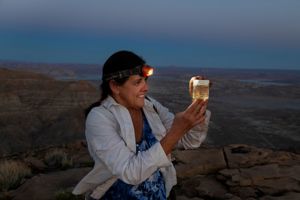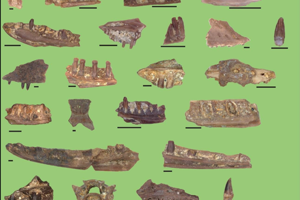CATALYST
DENVER MUSEUM OF NATURE & SCIENCE ONLINE MAGAZINE
Science Conversation: Miller Moths Are on the Move
Did You Know these Moths Can Make a Meal for a Hungry Grizzly Bear?

From left to right, Genevieve Anderegg, assistant collections manager of invertebrate zoology, Dr. John Brown, research associate at the National Museum of Natural History, and a research student capture moths at the Southwestern Research Station in the Chiricahua Mountains of southeastern Arizona in August, 2024. (Photo/ Chris Grinter)
Springtime means budding trees, singing birds and, here in Colorado, migrating miller moths. In this month of May, caterpillars, having survived a fierce winter, are metamorphosing into miller moths and taking off on a 100-mile journey from the Great Plains to the mountains.
These little guys use the light of the moon to guide their journey, but in urban areas, they can easily become disoriented by glowing electric lights. The moths get inside homes, where they can perish by smacking into a lightbulb or fall prey to carnivorous felines — if an annoyed human doesn’t swat them first. A few miller moths will even make it into the Museum, where we take precautions to protect our collections from the pests that feed on their remains.
Here we sit down with Genevieve Anderegg, assistant collections manager of invertebrate zoology at the Denver Museum of Nature & Science, to learn more about miller moths, their incredible journey each spring and the important role they play in maintaining healthy ecosystems.
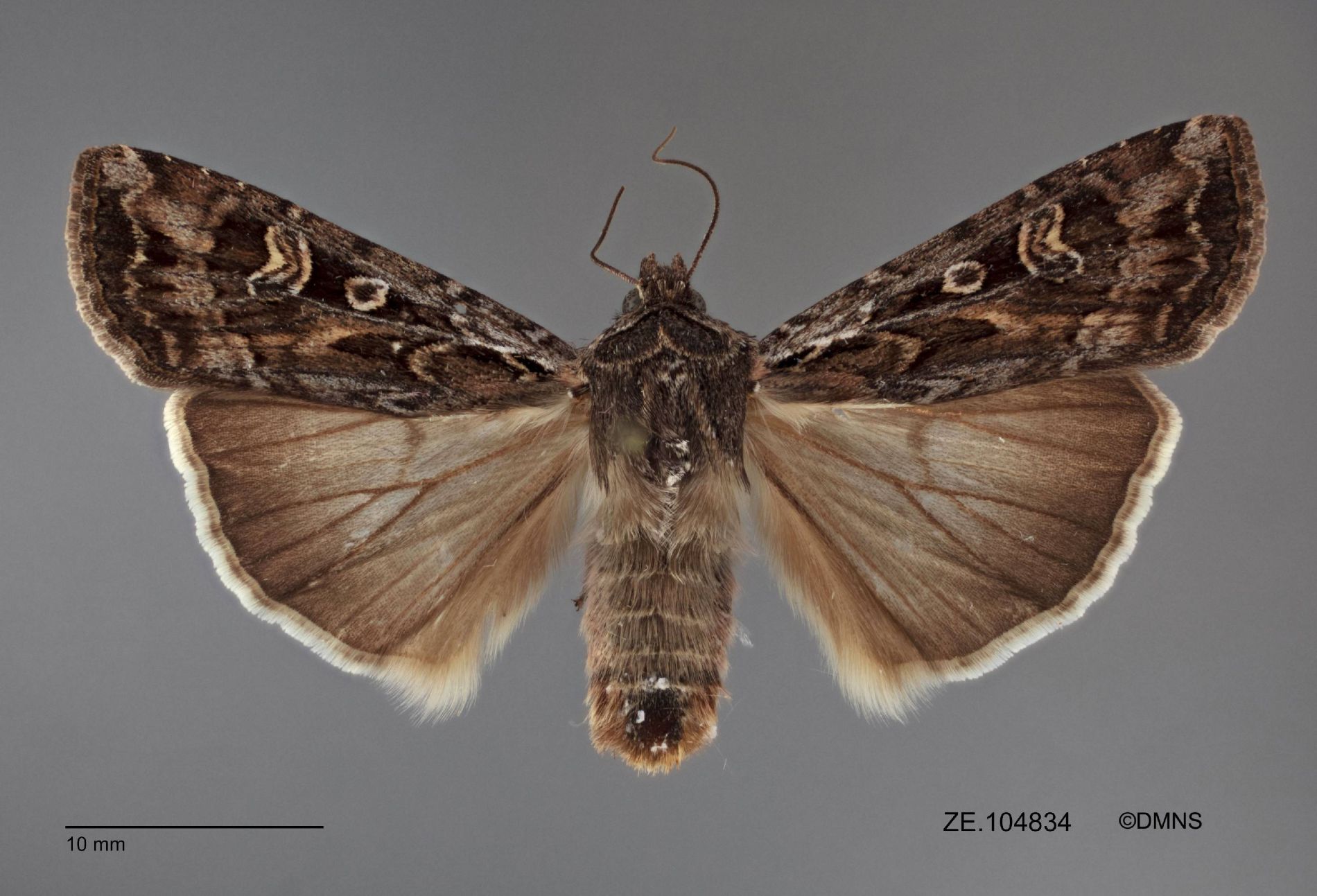
An adult miller moth collected by former Curator of Entomology Dr. Rick Peigler on May 19 , 1991 in Bear Creek, Colo. (Photo/ Meghan Shaw)
Why do miller moths migrate? Where are miller moths coming from and where are they going?
Miller moth eggs hatch in low elevation Great Plains farmlands in the fall, and the caterpillars, known as “army cutworms,” feed on vegetation, including wheat and corn. The caterpillars survive the winter, eating when possible until they are ready to pupate in the middle of spring. Then, they emerge as adults in the late spring and migrate to higher elevations in the west for cooler weather.
Miller moths migrate to the mountains to find food during the summer where they feed on nectar from flowers. The surviving population migrates back to the plains in late August and early September, but in much smaller numbers than the spring migration. Once the survivors arrive back to the lower elevations, they mate and lay eggs, beginning the next generation.

Anderegg in the field to survey and collect moths at the Southwestern Research Station, which is in the Chiricahua Mountains of southeastern Arizona in August, 2024. (Photo/ Chris Grinter)
What is an important role that miller moths play in ecosystems that people may not know about?
Miller moths are an important food source for many predators, mainly birds and bats, as well as other insects. During migration season, miller moths may take shelter and hide on the underside of cars during the day, and emerge when cars are stopped at intersections, creating the perfect hunting grounds for birds that feed on the moths. If you see many birds flying low and swooping over an intersection during the spring migration, they are likely feeding on miller moths coming out from underneath vehicles.
Outside of Colorado, grizzly bears also feed on miller moths in the mountains. Miller moths are a great food source for because their bodies are almost 75% fat, making them very nutritious and calorie-dense. Bears will snack on the moths that are resting on vegetation during the day.
Do humans interfere with the miller moth migration? If so, in what ways?
We interfere with the miller moth migration by simply living in between the prairies and the mountains. We have built a large city in the middle of their migration path, so they must pass through areas of human development to reach their summer habitat. Miller moths, like most moths, are nocturnal and sensitive to light, and our extensive use of lights impacts their ability to navigate. Moths may be attracted to house lights and become trapped in buildings, where they become an annoying pest in our living spaces.
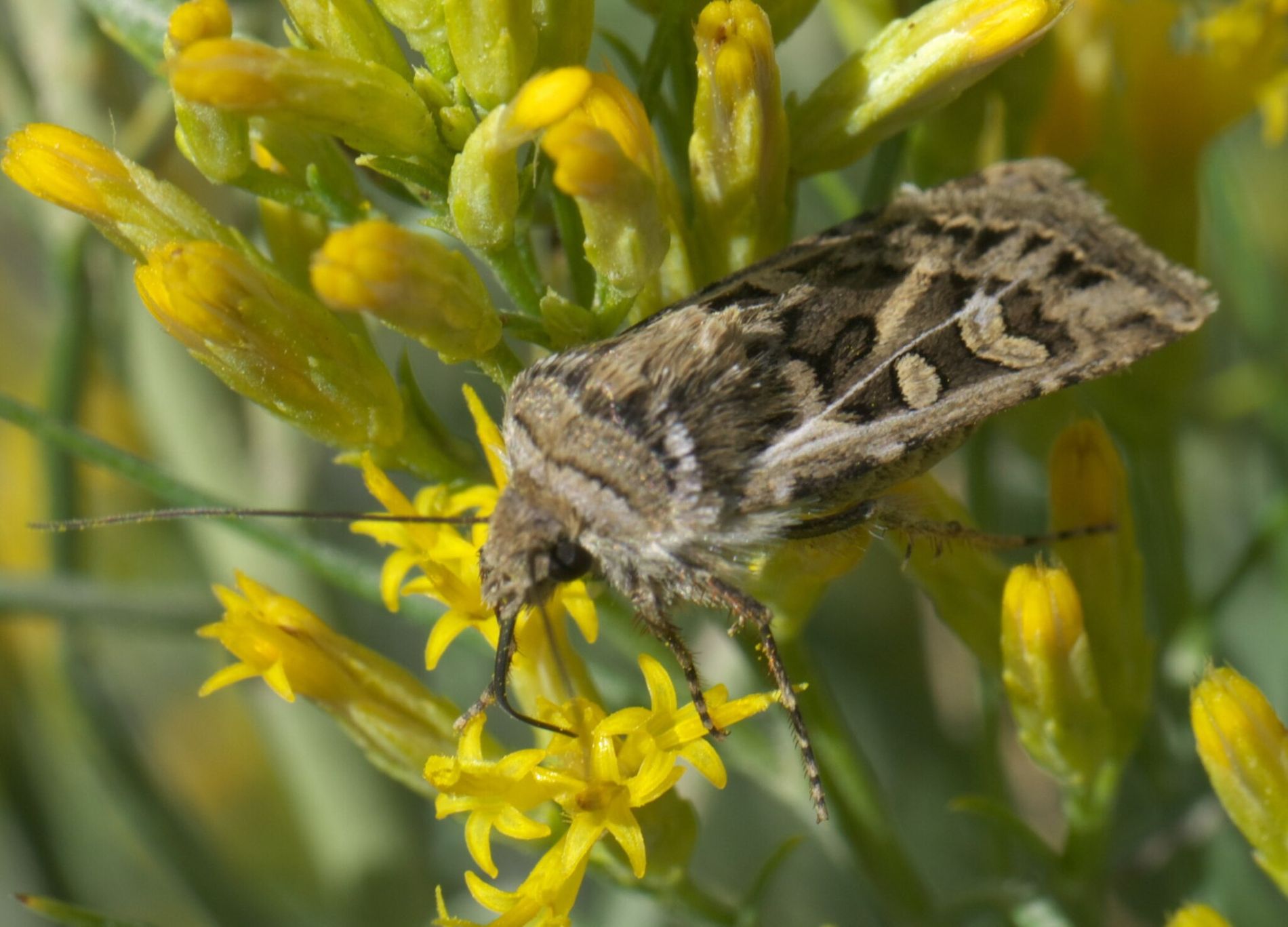
A miller moth feeds on nectar from a flower in Mineral County, Colo. (Photo/ Robert Webster via Wikimedia Commons)
Are there any ways to deter miller moths from entering our homes during their migration?
Tape up the edges of doors and windows, and turn off lights and minimize using doors after dark. Miller moths can fit through the smallest spaces, so remove any entrance to your home no matter how tiny. To clean moths inside of your home, swat or vacuum them up. It is important to remove dead moths so that they do not become food for other insects and spiders that may be inside your home.
To remove large numbers of moths from a room, hang a lightbulb above a bucket of soapy water in a dark room. The moths will be attracted to the light and fall into the bucket, and the soap will keep them from crawling out of the water.
What steps does the Museum take to prevent miller moths and other insects from damaging our collections?
The Museum has millions of objects in its collections that collections staff safeguard to ensure that they are not damaged by insects. Collections objects made of organic material, including anything from a plant or an animal, can be eaten by insects, especially clothes moths and carpet beetles — same thing with your sweaters! Miller moths themselves are not a threat to collections objects, because the adults feed only on nectar, but moths that make their way into collections areas and then die become attractants for other pests that are of greater concern. Collections staff keep objects stored in airtight cabinets, and cabinets in rooms with limited access and well-sealed doors. Members of the Museum’s PESTeam check for pests in our collections every month and clean up any intruders!
How are Colorado's miller moth populations doing? Should we be worried about them?
Miller moths (Euxoa auxiliaris) are a very successful species and are doing well regardless of human impacts, so we do not need to be worried about miller moths specifically. However, insects in general are all in great danger due to habitat loss, insecticides and climate change. Insect numbers have declined significantly in the last several decades, including the extinction of vulnerable species and great declines in more abundant species. A common anecdote is the number of insects that end up on your windshield when driving longer distances. Most people recall much greater numbers of insects collecting on their windshields several decades ago, and very few today.
You can help insect populations by reducing your overall impact on the environment, including using pest control methods that are not general insecticides, conserving habitats with large native biodiversity and staying informed. Insects pollinate the crops we eat and are an irreplaceable food source for other animals; without them, the food chain will be damaged beyond repair.
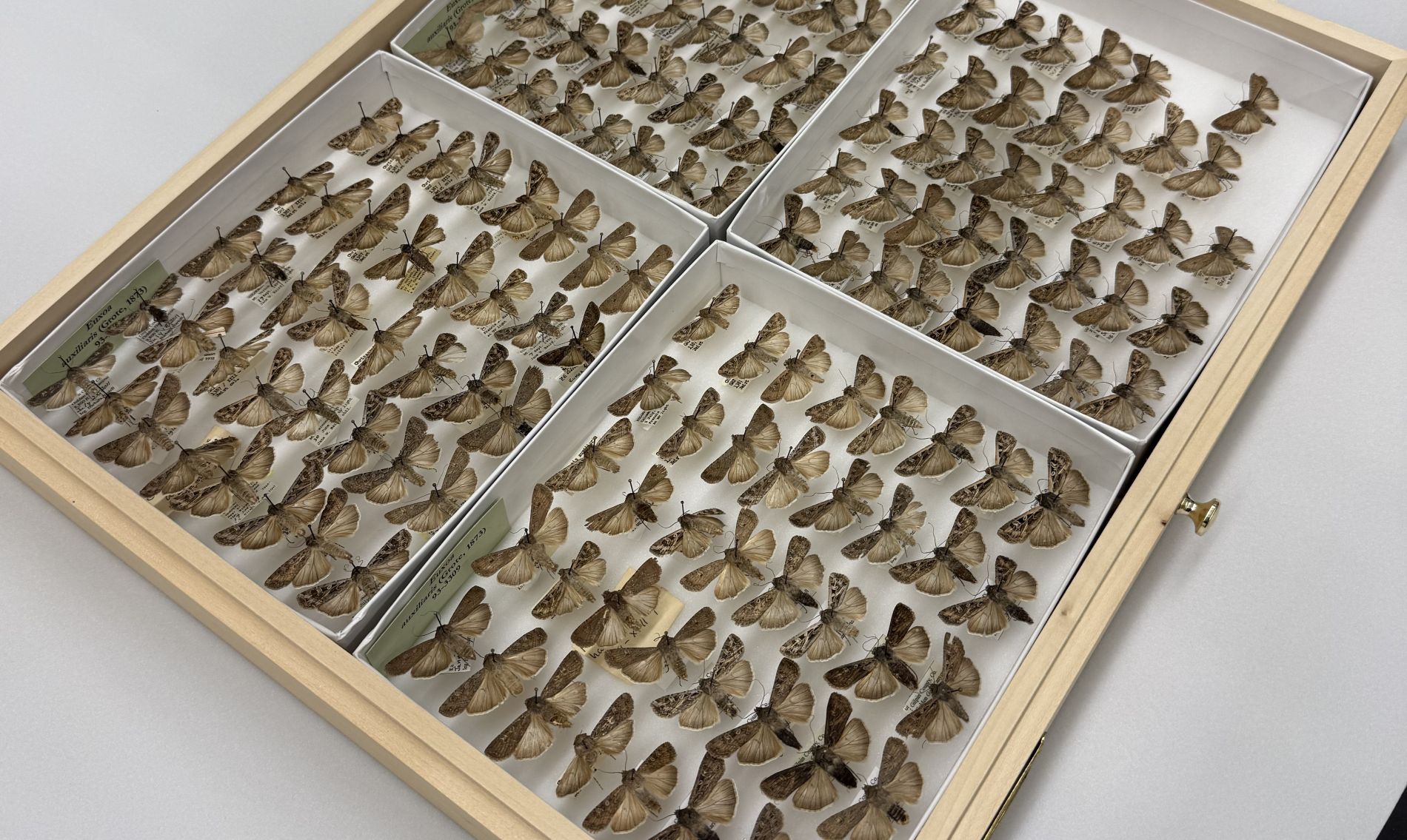
Miller moth specimens in the Entomology collection at the Denver Museum of Nature & Science. (Photo/ Taran Volckhausen)
Does the Museum have miller moths in its collection? Why is it important for the Museum to collect and preserve these specimens and how are they used in scientific research?
We have more than 139 specimens of the miller moth in our collection database, and we want to continue adding specimens to our collection because they serve to document the biodiversity of, specifically, the local area and the entire Earth. The only place to get moths from the past is in an Entomology collection, because you can never go back in time. We can compare specimens from different times and places to understand how species’ genetics, distribution and other traits may have changed or been influenced by factors like environment shifts, human activity and more. Combined with the billions of specimens in other natural history collections at thousands of museums and institutions around the world, we can learn endless things about life on Earth!
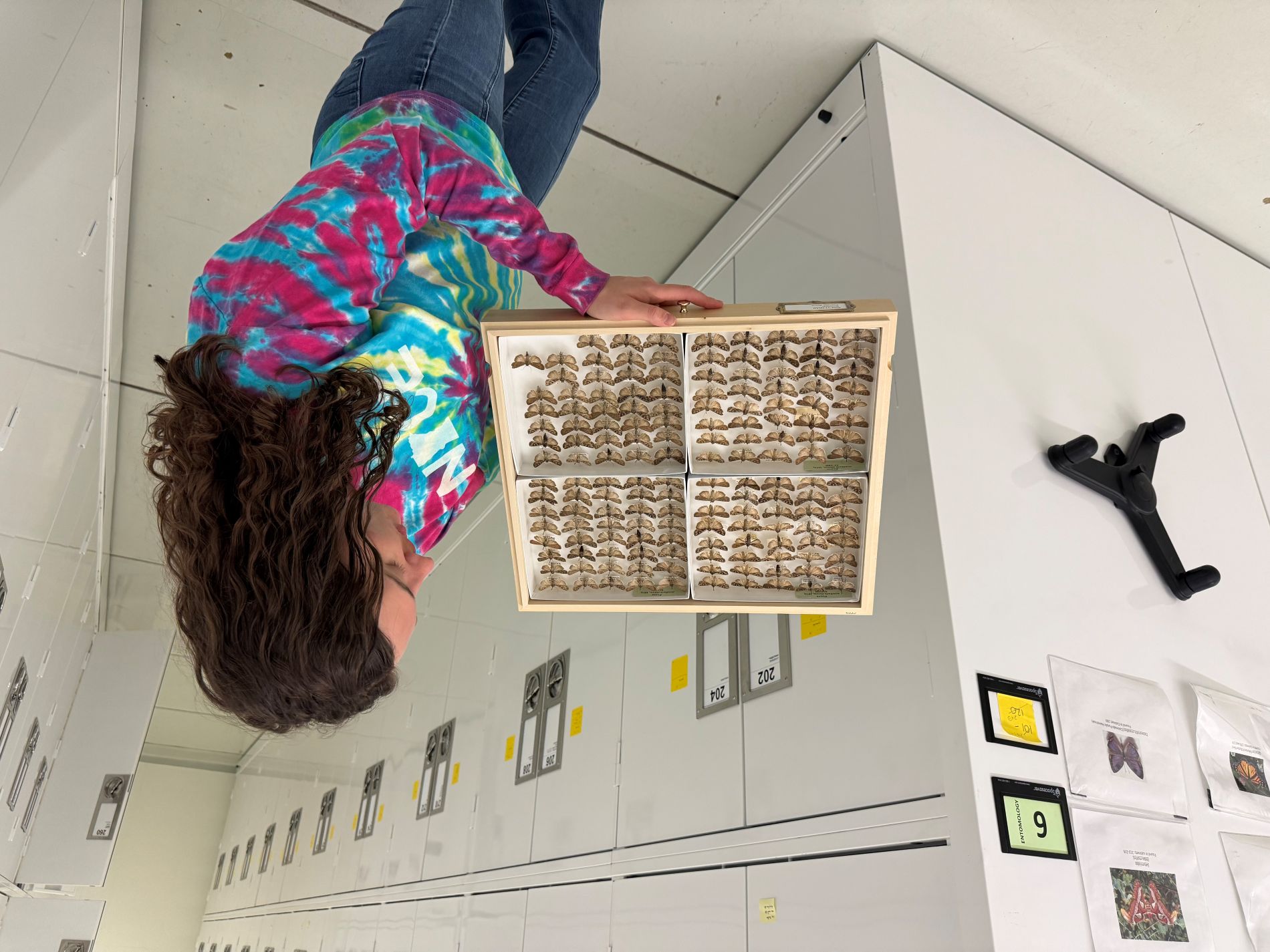
Anderegg holds a drawer filled with miller moth specimens in the Denver Museum of Nature & Science. (Photo/ Taran Volckhausen)



